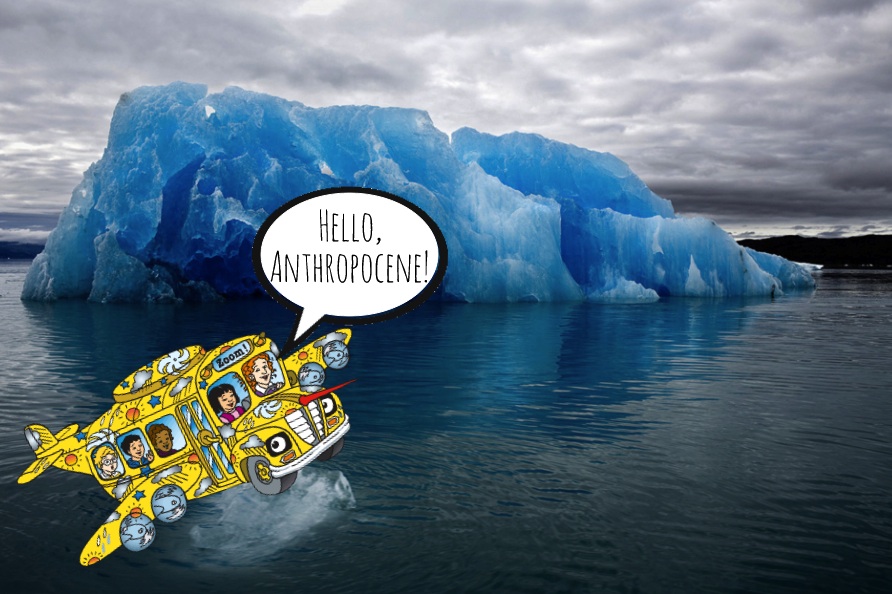 *
*
Not all of us have access to a magic school bus capable of shape-shifting. Nor can we guide eight wide-eyed students (“pupils with dilated pupils”?) through the human body for a lesson on digestion. Not everyone has the budget for such far-out field trips, let alone the permission to keep an uncaged lizard in the classroom. Nah, Ms. Frizzle has us beat.
I am at the University of Washington to become an English teacher. And the more we delve into the Honors 392 syllabus, the more I tinker and refine my goals for the future. How will I design my classroom with the Anthropocene in mind?
Literature concerns itself with the “human condition.” Recently, I’ve rethought the connotations of this term: it no longer sounds like a diagnosis, or struggle, or burden borne. No, the human condition is far more active; it includes agency, strength, duty. It’s not merely our emotions (“Gatsby feels sad in this chapter…”) but our impact. We aren’t just victims of the limbic system: to be human is to be powerful and responsible. This is nowhere more evident than in the Anthropocene.
The fourteenth and fifteenth chapters of Jeremy Rifkin’s The Empathic Civilization grasped me fast and fierce. I found much of his insights to be flint for thought. How might I incorporate technology into the classroom in a productive, novel way (#Gatsby)? How might I capitalize on the “collaborative psyche” of younger generations (586)? Surely some classes—weather permitting—should be held outdoors. Ditto to incorporating movement. Role-playing exercises, in which students are encouraged to adopt various perspectives, would also be crucial. (My summer at the Yale Conservatory for Actors will have primed me well.)
Rifkin quotes Abraham Maslow in stressing that we must “re-participate with nature.” This sounds awkward, clunky—but it’s true. Interacting with nature has become, well, “second-nature.” Rather than succumb to the cushion of our modern lifestyle, we must enforce “no-screen time,” taking walks, eating vegetables. Such re-participation is a skill that “has to be practiced” (611). We must actively engage our “old” brain systems and body movements; otherwise, we won’t feel fully human. After all: we were made to do more than scroll and retweet.
Lakeside School requires its Upper School students to embark on a weeklong Outdoor Trip. My spring on the Deschutes River was such a terrific challenge: I learned more in that week than in an entire semester. Forget uploading your thoughts to The Cloud: ponder the actual sky.
“Love grows brains,” said Mary Gordon of Roots of Empathy (their tagline should be: “it takes a classroom to raise a child”) (604). More than anything, this is what I hope to stress. Ms. Levy will not gain a reputation for being “soft” or “hokey,” but (I hope) intensely passionate about her subject—whether it be “leaves” of notebook paper or leaves on a tree, there’s love here.
More “fuel” for thought (gasoline for that magic bus!)
- A brilliant photo essay by students at Interlochen Arts Academy.
The final slide is particularly, ironically resonant.
Their teacher, Dr. Mary Ellen Newport says: “Creating art, in this case about climate change, clarifies for the artist what she does or doesn’t understand” (Vaughan-Lee). - Astronaut Mae Jemison: both “the arts and sciences are avatars of human creativity” (Vaughan-Lee). Maybe the science fair and the spring musical can become one?
- Want more mash-ups of art & science & education? Check out my new favorite resource for all things creatively Anthropocene: Global Oneness Network.
- And because we could always use a mini lesson, here’s more Ms. Frizzle.
Works Cited
Rifkin, Jeremy. The Empathic Civilization: The Race to Global Consciousness in a World in Crisis. Penguin Group, New York. 2009.
Seaman, Camille. “Melting Away.” Global Oneness Project.
https://www.globalonenessproject.org/library/photo-essays/melting-away#photo=1
*I created the above image using an original photo by Seaman and Google Images clipart.
Vaughan-Lee, Cleary. “Exploring Climate Change Through Art in the Classroom.” PBS Teachers Lounge. PBS Education. 20 October 2017.
http://www.pbs.org/education/blog/exploring-climate-change-through-art-in-the-sciencE-classroom
